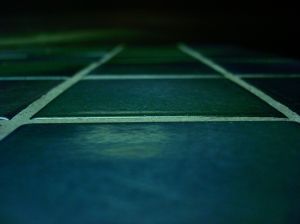Textured porcelain tile are used by many individuals as floor surfaces in showers, mud rooms, entry ways and other areas where slippery floor surfaces are not desired. The surface of the tile is rough and water resistant which provides a surface that is non-slippery when wet. Small nicks appear in the surface of the tile from extended use. Remove the nicks from the textured tile with 20 to 120-grit sandpaper. The sanding will remove the shiny surface or the tile in the sanded area.
In our home improvement business, we experimented with several different grits of sandpaper to achieve the same texture as textured porcelain tile. As a potter, I came to the conclusion that sanding ceramic surfaces to achieve a textured surface would work on the tile. Sanding works well but the right grit of sandpaper must be chosen. Start with the 20-grit sandpaper and work toward the 120-grit. Run your finger over the area between each grit sanding to see if the texture matches that of the tile. Remember, the tile has a coat of clear coat glaze on the surface to make it fairly smooth. The texture created by the sandpaper will feel slightly coarser than the texture on the tile. Once the repair is made, a sealer or polish is placed over the sanded area to create a repair that is virtually undetectable.
Materials Required:
Broom
Dustpan
Masking tape
20 to 120-grit sandpaper
Damp cloth
Process:
Step 1- Sweep the area and remove all debris.
Step 2 – Tape off the nick area with masking tape. Place the inside edges of the masking tape approximately 1/4-inch from the circumference of the nick.
Step 3 – Sand the edges of the nick with 60-grit sandpaper using a circular motion. Exert a light to moderate amount of pressure on the sandpaper during the sanding process.
Step 4 – Wipe the area with a damp cloth. Allow the tile to dry completely before continuing.
Step 5 – Check the sanded area for matching qualities in the texture of the tile. Sand the area a second time with 120-grit sandpaper if the area is too rough. Stop sanding if the area is similar to the texture of the tile.
Step 6 – Wipe the area with a damp cloth to remove sanding dust.
Step 7 – Remove the masking tape. Allow the area to dry completely.
Tips:
Experiment with the sanding process on a spare piece of tile prior to starting the project.
Sand the edges of larger nicks then fill with a clear a light-curing acrylic gel repair kit or a texture kit for granite. When using a light-curing acrylic gel repair kit, the gel is set using an LED light for approximately 2 minutes. Remove the LED light after 1 ½ minutes. Press a piece of sandpaper that is very close to the texture on the tile into the gel. Remove the sandpaper and hold the LED light over the gel for another 30 seconds. The finished patch will feel textured while the color of the tile shows through the clear gel.
Polish or seal the sanded area to match the remainder of the tile. The sanded area will look lighter than the rest of the tile due to the sanding. Once the polish or sealer is applied, the sanded area will blend in with the remainder of the flooring.





